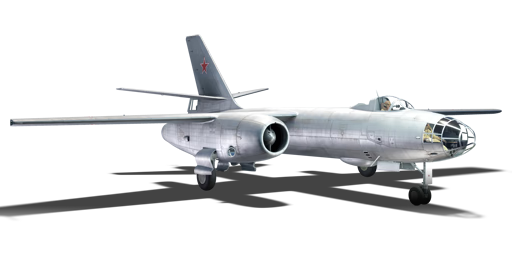



Towards the end of WWII, multiple captured German prototype jet bombers found their way into Soviet hands, and were quickly analysed and reverse-engineered. One of the first successful production jet bombers to incorporate the technologies learned from these planes was the new IL-28 bomber, which during testing not only fulfilled the requirements set out in 1948 for a new jet-powered frontline bomber, but went beyond when entering production with the upgraded VK-1 engines which were not available during testing (where it used RD-45 engines instead). The IL-28 would go on to become one of the staples of air forces of the Eastern Bloc during the '50s and '60s, seeing service in not only the allied Warsaw Pact nations, but also the Middle East, Africa, South America, Central Asia, and further expanded when China began licensed production of the aircraft as the Harbin H-5, exporting it to the neighbouring countries as well. The aircraft would serve a long and eventful life with the many countries it flew with, and remains in service even today with North Korea operating 80 of the airframe type as of 2023.
The IL-28, introduced in Update 1.43, is a Soviet post-war jet bomber that occupies the traditional role of the "fast bomber" previously endowed to aircraft like the Pe-2-359 Peshka. Thus, the aircraft was designed for speed and flight performance in mind. In-game, this translates into above average flight performance for its class, allowing the IL-28 to disengage and manoeuvre easily against threats. Another shining feature of the IL-28 is its powerful anti-aircraft armament. In addition to the deadly twin NR-23 cannons in the turret covering the rear hemisphere, the IL-28 has access to two more NR-23s mounted frontally in the nose, controlled by the pilot. This allows the IL-28 to opportunistically prey on lighter ground targets or distracted enemy aircraft when the chance arises.
flaps
flaps
flaps
brake
| Belt | Belt filling | Armor penetration (mm) at a distance: | |||||
|---|---|---|---|---|---|---|---|
| 10 m | 100 m | 500 m | 1000 m | 1500 m | 2000 m | ||
| AP-I/FI-T | 32 | 30 | 22 | 15 | 10 | 7 | |
| FI-T/AP-I/AP-I/AP-I | 32 | 30 | 22 | 15 | 10 | 7 | |
| FI-T/FI-T/FI-T/AP-I | 32 | 30 | 22 | 15 | 10 | 7 | |
| AP-I | 32 | 30 | 22 | 15 | 10 | 7 | |
| Belt | Belt filling | Armor penetration (mm) at a distance: | |||||
|---|---|---|---|---|---|---|---|
| 10 m | 100 m | 500 m | 1000 m | 1500 m | 2000 m | ||
| AP-I/FI-T | 32 | 30 | 22 | 15 | 10 | 7 | |
| AP-I/AP-I/AP-I/FI-T | 32 | 30 | 22 | 15 | 10 | 7 | |
| FI-T | 4 | 4 | 3 | 2 | 2 | 2 | |












Flight performance | |
|---|---|
Survivability |
|---|
Weaponry | |
|---|---|